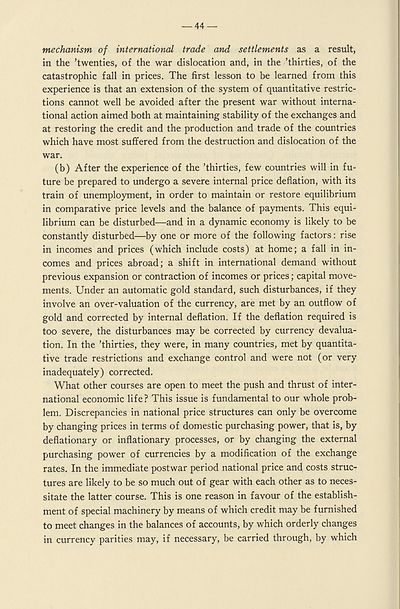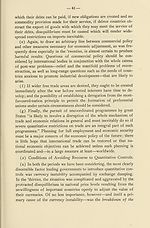Download files
Complete book:
Individual page:
Thumbnail gallery: Grid view | List view

44
mechanism of international trade and settlements as a result,
in the ’twenties, of the war dislocation and, in the ’thirties, of the
catastrophic fall in prices. The first lesson to be learned from this
experience is that an extension of the system of quantitative restric¬
tions cannot well be avoided after the present war without interna¬
tional action aimed both at maintaining stability of the exchanges and
at restoring the credit and the production and trade of the countries
which have most suffered from the destruction and dislocation of the
war.
(b) After the experience of the ’thirties, few countries will in fu¬
ture be prepared to undergo a severe internal price deflation, with its
train of unemployment, in order to maintain or restore equilibrium
in comparative price levels and the balance of payments. This equi¬
librium can be disturbed—and in a dynamic economy is likely to be
constantly disturbed—by one or more of the following factors: rise
in incomes and prices (which include costs) at home; a fall in in¬
comes and prices abroad; a shift in international demand without
previous expansion or contraction of incomes or prices; capital move¬
ments. Under an automatic gold standard, such disturbances, if they
involve an over-valuation of the currency, are met by an outflow of
gold and corrected by internal deflation. If the deflation required is
too severe, the disturbances may be corrected by currency devalua¬
tion. In the ’thirties, they were, in many countries, met by quantita¬
tive trade restrictions and exchange control and were not (or very
inadequately) corrected.
What other courses are open to meet the push and thrust of inter¬
national economic life? This issue is fundamental to our whole prob¬
lem. Discrepancies in national price structures can only be overcome
by changing prices in terms of domestic purchasing power, that is, by
deflationary or inflationary processes, or by changing the external
purchasing power of currencies by a modification of the exchange
rates. In the immediate postwar period national price and costs struc¬
tures are likely to be so much out of gear with each other as to neces¬
sitate the latter course. This is one reason in favour of the establish¬
ment of special machinery by means of which credit may be furnished
to meet changes in the balances of accounts, by which orderly changes
in currency parities may, if necessary, be carried through, by which
mechanism of international trade and settlements as a result,
in the ’twenties, of the war dislocation and, in the ’thirties, of the
catastrophic fall in prices. The first lesson to be learned from this
experience is that an extension of the system of quantitative restric¬
tions cannot well be avoided after the present war without interna¬
tional action aimed both at maintaining stability of the exchanges and
at restoring the credit and the production and trade of the countries
which have most suffered from the destruction and dislocation of the
war.
(b) After the experience of the ’thirties, few countries will in fu¬
ture be prepared to undergo a severe internal price deflation, with its
train of unemployment, in order to maintain or restore equilibrium
in comparative price levels and the balance of payments. This equi¬
librium can be disturbed—and in a dynamic economy is likely to be
constantly disturbed—by one or more of the following factors: rise
in incomes and prices (which include costs) at home; a fall in in¬
comes and prices abroad; a shift in international demand without
previous expansion or contraction of incomes or prices; capital move¬
ments. Under an automatic gold standard, such disturbances, if they
involve an over-valuation of the currency, are met by an outflow of
gold and corrected by internal deflation. If the deflation required is
too severe, the disturbances may be corrected by currency devalua¬
tion. In the ’thirties, they were, in many countries, met by quantita¬
tive trade restrictions and exchange control and were not (or very
inadequately) corrected.
What other courses are open to meet the push and thrust of inter¬
national economic life? This issue is fundamental to our whole prob¬
lem. Discrepancies in national price structures can only be overcome
by changing prices in terms of domestic purchasing power, that is, by
deflationary or inflationary processes, or by changing the external
purchasing power of currencies by a modification of the exchange
rates. In the immediate postwar period national price and costs struc¬
tures are likely to be so much out of gear with each other as to neces¬
sitate the latter course. This is one reason in favour of the establish¬
ment of special machinery by means of which credit may be furnished
to meet changes in the balances of accounts, by which orderly changes
in currency parities may, if necessary, be carried through, by which
Set display mode to:
![]() Universal Viewer |
Universal Viewer | ![]() Mirador |
Large image | Transcription
Mirador |
Large image | Transcription
Images and transcriptions on this page, including medium image downloads, may be used under the Creative Commons Attribution 4.0 International Licence unless otherwise stated. ![]()
| League of Nations > Economic and financial section > Quantitative trade controls > (46) |
|---|
| Permanent URL | https://digital.nls.uk/190588591 |
|---|
| Shelfmark | LN.II |
|---|
| Description | Over 1,200 documents from the non-political organs of the League of Nations that dealt with health, disarmament, economic and financial matters for the duration of the League (1919-1945). Also online are statistical bulletins, essential facts, and an overview of the League by the first Secretary General, Sir Eric Drummond. These items are part of the Official Publications collection at the National Library of Scotland. |
|---|---|
| Additional NLS resources: |
|

